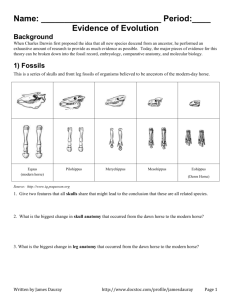2 Evolution Evidence of Evolution Assignment
advertisement
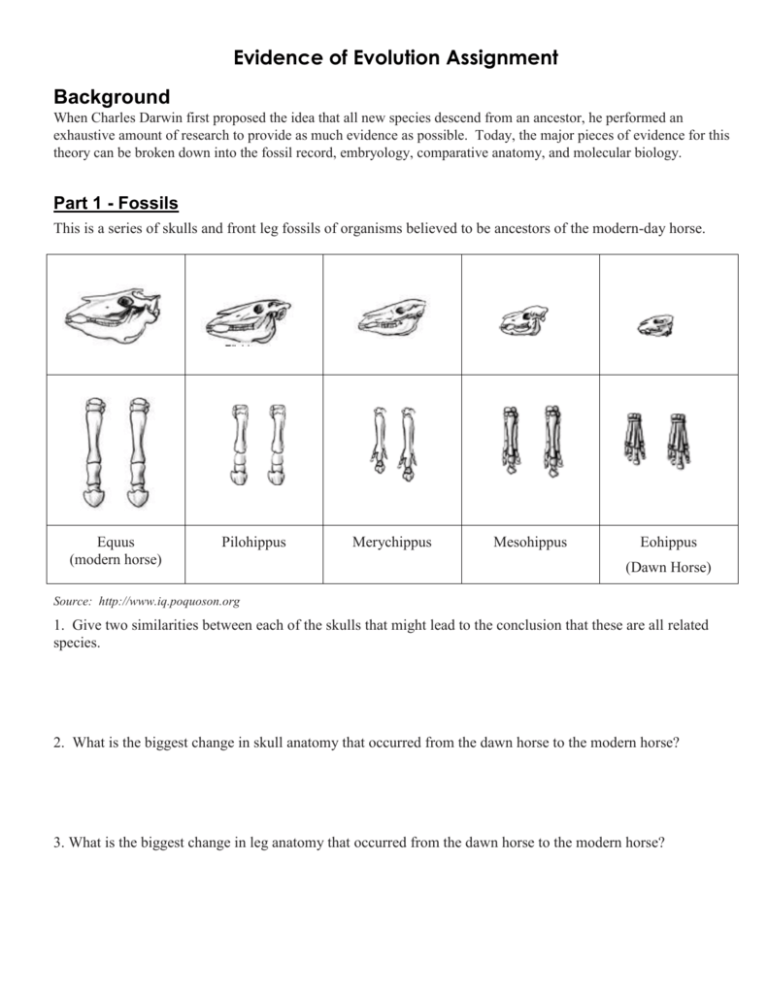
Evidence of Evolution Assignment Background When Charles Darwin first proposed the idea that all new species descend from an ancestor, he performed an exhaustive amount of research to provide as much evidence as possible. Today, the major pieces of evidence for this theory can be broken down into the fossil record, embryology, comparative anatomy, and molecular biology. Part 1 - Fossils This is a series of skulls and front leg fossils of organisms believed to be ancestors of the modern-day horse. Equus (modern horse) Pilohippus Merychippus Mesohippus Eohippus (Dawn Horse) Source: http://www.iq.poquoson.org 1. Give two similarities between each of the skulls that might lead to the conclusion that these are all related species. 2. What is the biggest change in skull anatomy that occurred from the dawn horse to the modern horse? 3. What is the biggest change in leg anatomy that occurred from the dawn horse to the modern horse? Part II - Comparative Anatomy Figure 1 Homologous Structures Carefully examine the drawings of the bones shown in Figure 1. Note similar positions of like bones. Describe the function of each set of bones in the table below. Animal Human Whale Frog Bat Bird lizard cow Function Holding objects Are the bones arranged in a similar way for each organism? ____________________________________ These structures are formed in similar ways during embryonic development and share like arrangements; however they have different forms and functions. Analogous Structures Examine the insect wing and the bird wing in figure 2. Figure 2 What functions do these structures share? ________________________________________ How do these structures differ? ________________________________________ ________________________________________ Do birds and insects share any structural similarities that would suggest that they are related taxonomically (with common ancestors)? ________________________________________________ Some apparently unrelated animals have organs with similar functions, yet they are very different in structure and form. This difference suggests that they evolved independently of one another over time. Part III – Vestigial Organs Gradual changes over time that have in some cases reduced or removed the function of some body structures and organs. Penguin wings (no longer birds of flight) and leg bones of snakes (only slither, don’t walk) are examples of this phenomenon. Figure 3. The cave fish and the minnow below are related but the cave fish is blind. minnow Explain why eyesight is not an important adaptation to life in a cave._______________________________________________ Does the appearance of the cave fish and the minnow suggest a common ancestry? Explain. cave minnow ______________________________________________________________________________ What kind of sensory adaptation would you hypothesize the cave fish has to allow it to navigate in a cave, including catching and eating food? _______________________________________________________ Human vestigial organs are well documented. In the table below suggest a possible function for each of the vestigial organs and suggest a reason why it Figure 4 became vestigial. Structure appendix Probable Function Digestion (remains of a ruminant stomach) Reason for it being vestigial Diet has changed Coccyx (tail bone) Muscles that move ears Muscles that make hair stand up Little toe Wisdom teeth How are vestigial structures an example of evidence of evolution? Part IV – Embryology ("ontogeny recapitulates phylogeny") Organisms that are closely related may also have physical similarities before they are even born! Take a look at the six different embryos below: Source: http://www.starlarvae.org Hypothesize which embryo is from each of the following organisms: Species Human Embryo Chicken Rabbit Tortoise Salamander Fish These are older, more developed embryos from the same organisms. Hypothesize which embryo is from each of the following organisms: Species Human Chicken Rabbit Tortoise Salamander Fish Embryo These are embryos at their most advanced stage, shortly before birth. Describe how the embryos changed for each of these organisms from their earliest to latest stages. Species Human Anatomical Changes From Early to Late Stages Chicken Rabbit Tortoise Salamander Fish 1. Look again at the six embryos in their earliest stages. Describe the patterns you see. What physical similarities exist between each of the embryos? 2. Does this suggest an evolutionary relationship? Explain how these embryos can be used as evidence of a common ancestor between each of these six organisms? Part V - Molecular Biology Cytochrome c is a protein found in mitochondria. It is used in the study of evolutionary relationships because most animals have this protein. Cytochrome c is made of 104 amino acids joined together. Below is a list of the amino acids in part of a cytochrome protein molecule for 9 different animals. Any sequences exactly the same for all animals have been skipped. For each non-human animal, take a highlighter and mark any amino acids that are different than the human sequence. When you finish, record how many differences you found in the table on the next page. 42 43 44 46 47 49 50 53 54 55 56 57 Human Q A P Y S T A K N K G I Chicken Q A E F S T D K N K G I Horse Q A P F T T D K N K G I Tuna Q A E Y S T D K S K G I Frog Q A A F S T D K N K G I Shark Q A Q F S T D K S K G I Turtle Q A E F S T E K N K G I Monkey Q A P Y S T A K N K G I Rabbit Q A V F S T D K N K G I 58 60 61 62 63 64 65 66 100 101 102 103 104 Human I G E D T L M E K A T N E Horse T K E E T L M E K A T N E Chicken T G E D T L M E D A T S K Tuna V N N D T L M E S A T S - Frog T G E D T L M E S A C S K Shark T Q Q E T L R I K T A A S Turtle T G E E T L M E D A T S K Monkey T G E D T L M E K A T N E Rabbit T G E D T L M E K A T N E Animal Number of Amino Acid Differences Compared to Human Cytochrome C Animal Horse Shark Chicken Turtle Tuna Monkey Frog Rabbit Number of Amino Acid Differences Compared to Human Cytochrome C Molecular Biology – Summary Questions 1. Based on the Cytochrome C data, which organism is most closely related to humans? 2. Do any of the organisms have the same number of differences from human Cytochrome C? In situations like this, how would you decide which is more closely related to humans? Conclusion 1. Charles Darwin published his book On the Origin of Species in 1859. Of the different types of evidence that you have examined, which do you think he relied upon the most, and why? 2. Given the amount of research and evidence available on evolution, why is it classified as a theory?
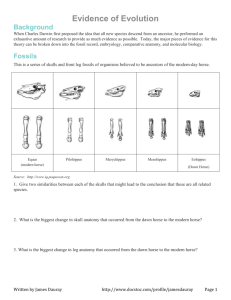
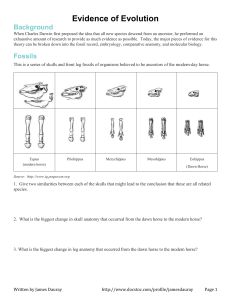
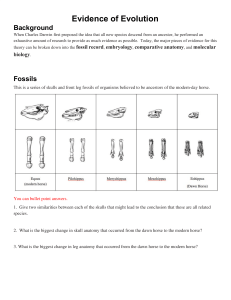
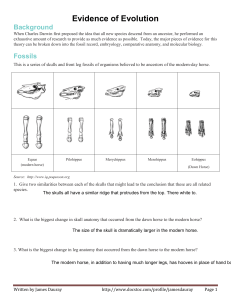
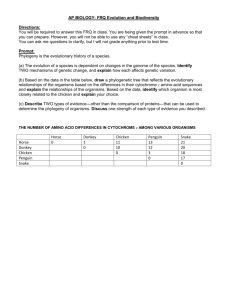
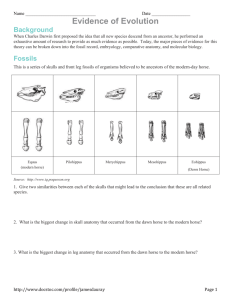
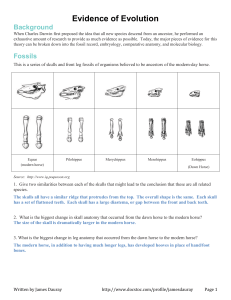
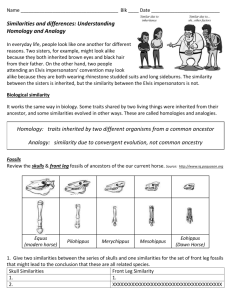
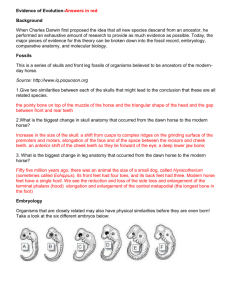
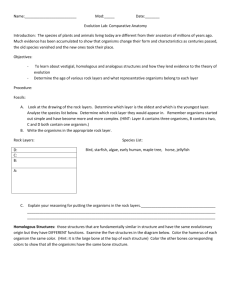
![Evidences_for_Evolution[1]](http://s2.studylib.net/store/data/005782474_2-92d918c9fbb15c5c4fb484555d2a0a0a-300x300.png)

